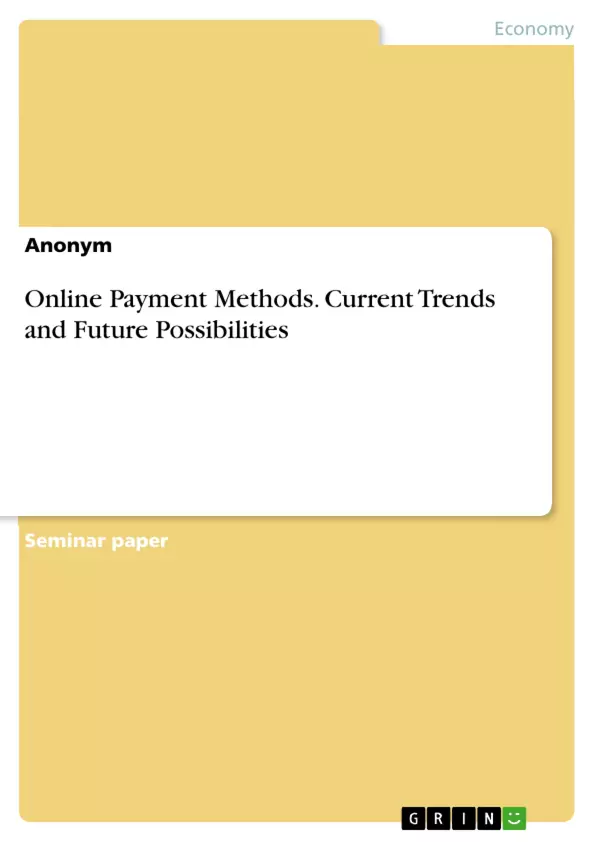The aim of this paper is to record the payment systems available on the market and to categorize them. The focus in this thesis is placed on the B2C Sector, as this is where most online transactions take place. It will then be analyzed what significance the payment methods can have for the customer on the one hand, and for the merchant in e-commerce on the other. What are the current trends in payment methods, what are the future megatrends and therefore the future possible payment methods in online shops? This are the main topics, this thesis is about.
Chapter 2 deals with the relevant definitions that are important for the thesis. The general requirements of a payment system are then discussed in Chapter 3 and finally categorized in Chapter 4. The classic and modern payment systems in the internet are discussed in chapter 5, including their respective advantages and disadvantages. Chapter 6 takes a closer look at 4 of the 10 largest online shops and analyses which payment systems are offered there and in generally, are most used today. Further in chapter 7 and 8, an outlook on possible future payment methods is given. A survey was also conducted for this seminar paper, which is discussed in chapter 9.
Inhaltsverzeichnis (Table of Contents)
- Introduction
- Issue and Objectives of the Thesis
- Structure
- Definitions
- Definition of payment transactions
- Definition B2B
- Definition B2C
- General requirements of an electronic payment system
- Usability and convenience
- Safety and reliability
- Transferability
- Confidentiality
- Rentability and costs
- Categorization of Payment options
- Categorization according by payment date
- Categorization according by payment amount
- Internet payment systems
- Classic payment systems
- Invoice
- Credit Card
- SEPA Direct Debit
- Prepayment
- PayPal
- Modern payment Systems
- DIRECT banking
- Apple Pay / Google Pay
- Amazon Payments
- Factoring - Using the example of Klarna
- Currently most offered online payment methods by analyzing largest Online shops
- Possible future payment methods on the Internet
- Bitcoin
- E-Euro
- Three megatrends about the future of payment
- Trend 1 immediate
- Trend 2-frictionless
- Trend 3-transparency
- Results of the survey
- Final assessment
- Summary
- Outlook
Zielsetzung und Themenschwerpunkte (Objectives and Key Themes)
This thesis aims to document and categorize the various payment systems available on the market, with a primary focus on the B2C sector, where most online transactions occur. It examines the significance of these payment methods for both customers and merchants in e-commerce. The main themes explored include current trends in payment methods, future megatrends shaping the online payment landscape, and potential future payment methods for online shops.
- Categorization and analysis of payment systems in the B2C sector.
- Assessment of the importance of payment methods for both customers and merchants in online commerce.
- Examination of current trends in online payment methods.
- Exploration of future megatrends and potential payment methods in online shops.
- Evaluation of the results of a survey on online payment preferences.
Zusammenfassung der Kapitel (Chapter Summaries)
Chapter 2 provides definitions essential for understanding the thesis, including the definition of payment transactions and B2B and B2C interactions. Chapter 3 explores the general requirements of an electronic payment system, covering aspects like usability, safety, transferability, confidentiality, and profitability. Chapter 4 categorizes payment options based on payment date and amount.
Chapter 5 delves into classic and modern online payment systems, outlining their advantages and disadvantages. This chapter examines methods such as invoices, credit cards, SEPA direct debit, prepayment, PayPal, DIRECT banking, Apple Pay/Google Pay, Amazon Payments, and factoring, using Klarna as an example. Chapter 6 analyzes the payment systems offered by four of the ten largest online shops in Germany to understand the most commonly used methods.
Schlüsselwörter (Keywords)
This thesis focuses on online payment methods, their categorization, significance for customers and merchants, current trends, future megatrends, and potential future payment systems. Key topics include B2C commerce, payment system requirements, classic and modern payment methods, online shop payment offerings, and emerging payment technologies like Bitcoin and E-Euro.
- Arbeit zitieren
- Anonym (Autor:in), 2020, Online Payment Methods. Current Trends and Future Possibilities, München, GRIN Verlag, https://www.grin.com/document/1027447



